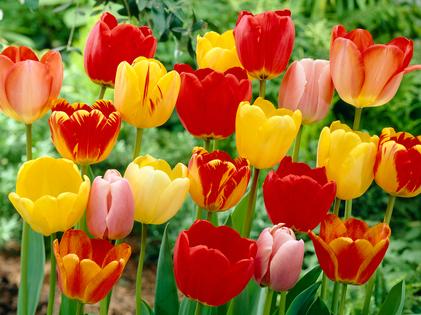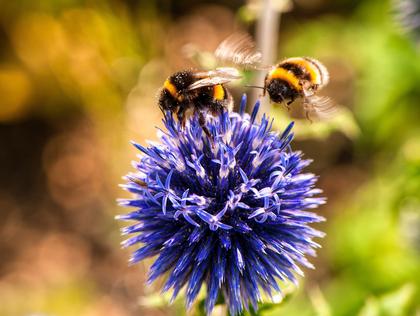
Flower Bulbs 101: Planting & Storage
In this article, we highlight some of the most frequently asked questions we receive regarding flower bulb planting and storage.

What is the best time to plant Fall bulbs?
Soil temperatures must be 55 F or below to ensure proper root development before winter sets in (mid-October to early-November in zones 6 & 7).
In most areas, the optimal planting time is when Autumn night-time temperatures drop down between 40° to 50° F.
Most Fall bulbs require a minimum cold frame of 6 weeks to root properly; Tulips in particular need 12 to 16 weeks in the dark with a sustained soil temperature below 50° F.
Daffodils are a notable exception, and do not require any cooling to bloom.
Planting when the soil temperature is too warm is the primary cause of short or stunted blooms come Spring.
For bulbs that have been pre-cooled, it is critical to plant immediately upon receipt to avoid losing the benefits of the pre-cooling.
These days, we automatically pre-cool all landscape bulbs from North Carolina south to supplement the limited natural cooling that is received during mild Mid-Atlantic and Southern winters.
What is the best time to plant Spring bulbs?
Soil temperatures must be 60 F or higher to ensure proper root development (mid-April to early-May in zones 6 & 7).
In most areas, the optimal planting time is when Spring night-time temperatures rise up between 40° and 50° F (and the danger of frost has passed).
In the Fall, tender Spring bulbs can be dug up and stored indoors in a cool, dry place to over-winter for planting again the following Spring.
Lilies are a notable exception; these summer bloomers are winter-hardy perennials.
How should bulbs be stored prior to planting?
Store bulbs in a cool, dry spot with good air circulation and low humidity.
Protect from heat, frost and strong sunlight.
Most bulbs can tolerate temperatures between 38 – 70 degrees F.
Temperatures between 50 – 60 F are ideal.
Lilies and bare root perennials are notable exceptions; these are best stored frozen to prevent sprouting.
Poor storage conditions may cause bulbs to dry out, or to become moldy.
Not sure if a bulb is viable? Look for bulbs that are firm to the touch.
What are the ideal soil conditions for bulbs?
Good drainage and plenty of sunlight are critical.
Never plant bulbs where water pools, all bulbs are harmed by "wet feet”.
The ideal pH level for bulbs is between 6 and 7.
If you have heavy clay soil, loosen to 10" deep before planting, and add topsoil, compost or peat to lighten the soil.
The general rule of thumb is to plant tulip & daffodil bulbs at a depth that is 3 times their height (generally 6-8” deep).
Plant 4-6” apart depending on desired display.
Cover with 3-4” of soil.
Water thoroughly after planting.
Although not required, a slow release nitrogen-phosphorus-potassium fertilizer (10-10-10 or 3-5-3) can be applied - we like Espoma Organic Bulb Tone.
Ideal bulb-tone timing: Early Spring when the first shoots push thru the soil and/or after flowering.
Early bloomers can be planted under trees where they will get enough sunlight prior to leaves re-growing.
How deep should I plant my bulbs?
A general rule of thumb is to plant bulbs at a depth of 2.5 times the height of the bulb.
Not planting bulbs deep enough results in poor rooting, and leads to an uneven and short plants.
Conversely, planting bulbs too deep can result in rotting as or late emergence.
Got a topic you'd like to see us cover in a future article? E-mail Chris with your suggestions and we'll get to work!
Latest Posts
Latest Posts
-
August 03, 2020Chris Ruigrok
-
July 02, 2020Patricia Vecchio
-
June 05, 2020Patricia Vecchio




